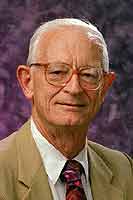|
|
|
|
Alan G. MacDiarmid
|
||
|
Blanchard Professor of Chemistry
|
||
 |
||
|
Alan
MacDiarmid, HYIco-discoverer of the field of conducting polymers, more commonly
known as "synthetic metals," was the chemist responsible in
1977 for the chemical and electrochemical doping of polyacetylene, (CH)x,
the "prototype" conducting polymer, and the "rediscovery"
of polyaniline, now the foremost industrial conducting polymer.
In
1973, he began research on (SN)x, an unusual polymeric material with metallic
conductivity. His interest in organic conducting polymers began in 1975
when he was introduced to a new form of polyacetylene by Dr. Hideki Shirakawa
at the Tokyo Institute of Technology.
This initial discovery and ensuing studies, in collaboration with Shirakawa, resulted in the first chemical doping of (CH)x and detailed physics studies with Heeger. That an organic polymer could be readily doped to the metallic regime introduced a phenomenon, completely new and unexpected to both the chemistry and physics communities. This unleashed a flood-gate of research world-wide in chemistry and physics concerning interrelationships between the chemistry, structure and electronic properties of semiconducting and metallic organic polymers which has continued to expand unabatedly to this day. Technological opportunities for application of these materials in such diverse areas as rechargeable batteries, electromagnetic interference shielding, antistatic dissipation, stealth applications, corrosion inhibition, flexible "plastic" transistors and electrodes, electroluminescent polymer displays, to name but a few, continue to be actively pursued. MacDiarmid’s current scientific interests are centered around the most technologically important conducting polymer, polyaniline, and its oligomers with special interest in those isomeric forms which might contribute to the greatest degree in promoting high conductivity and enhanced mechanical properties in polyaniline. He is also actively involved in the study of aniline oligomers in reversible sensors for volatile organic compounds down to a few ppm. His studies on light-emitting organic polymers involve investigation of the new phenomenon in which traces of ionic species in the emissive layer greatly enhance selected desirable characteristics. MacDiarmid was born in New Zealand 71 years ago and after obtaining his higher education at the University of New Zealand, University of Wisconsin and Cambridge University he joined the faculty of the University of Pennsylvania in 1955, where he is currently Blanchard Professor of Chemistry. During
the past 20 years he has been involved exclusively with conducting polymers,
particularly the synthesis, chemistry, doping, electrochemistry, conductivity,
magnetic and optical properties and processing of polyacetylene and polyaniline.
He is the author/co-author of approximately 600 research papers and 20
patents. He is the recipient of numerous awards and honorary degrees both
nationally internationally. Most recently, he was named recipient of the
1999 American Chemical Society Award in Materials Chemistry, which will
be presented at the society's National Meeting in Anaheim, CA in March
1999. |
||